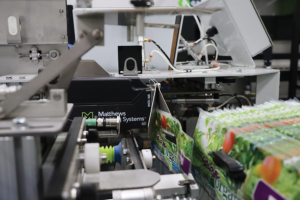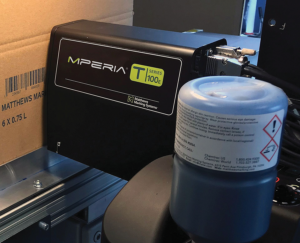Traceability initiatives can drive productivity, profitability
Nearly everyone in the produce industry has implemented produce traceability initiative (PTI) of some sort. Improved marking and coding can help produce processors set themselves up for PTI success.
One of the fastest, most cost-effective ways produce suppliers can improve traceability and profitability is to update marking and labeling technologies.

The product codes that identify the origins of every piece, package, crate and box of produce are an essential aspect of PTI. To avoid problems, these codes must be durable and easily readable — by humans and by scanning equipment — throughout the supply chain, from farm to consumer.
When codes are lost or are unreadable, producers lose time, product and profits.
Entire crates and pallets of perishables are misrouted or stuck in retail holds until they spoil. Items can be improperly identified, shelved or priced. And traceability becomes next to impossible, resulting in further costs for recalls and noncompliance.
Clean, durable marks are a critical first step in driving successful traceability. Advanced, tech-enabled marking and coding solutions should include:
- High-quality marks made with inks that won’t smear in damp, cool or hot conditions — whether printed on labels, cartons or directly on produce.
- Durable labels that don’t come off during processing, shipping or shelving.
- Robust marking and coding equipment that requires minimal maintenance and is ready to implement 2D barcodes.
- Automated print controllers that are easy to use and integrate with existing printers, barcode readers and vision systems.
- Effective integration with ERP and other back-end software to efficiently manage recalls, comply with PTI and stay ahead of regulatory changes.
BARCODES OF THE FUTURE — NOW
2D barcodes are fast becoming the industry standard. There are two main types of 2D barcodes: data matrix, which is most often used for supply chain applications; and QR codes, which are used for communicating product information for consumers.
By providing more detailed product information, 2D codes enable faster response throughout the supply chain when product tracking or recall issues arise. QR codes help to build brand awareness, confidence and loyalty by enabling anyone with a smartphone to scan a code and access a database with information about a food and its origins.
Transition to 2D codes still poses some challenges, as legacy systems and barcode scanners used by many producers are ill-equipped to work with 2D marks.
Whether linear barcodes or 2D codes, accurate marks are vital. If marking equipment can produce quality 1D marks, chances are it can also produce 2D barcodes. More challenging for producers will be integrating existing printers with back-end systems so the marking process is efficient and accurate.
Even if companies are still relying on 1D barcodes, upgrading marking and coding equipment will help ensure they are future ready.

A PACKAGING CASE IN POINT
Reliance on manual labor for bagging and labeling poses a major challenge for fruit packaging operations. Fruit is fragile, so packagers have traditionally hand labeled each bag or pouch — a time-consuming and expensive process that also slows production because workers cannot match the speed of automated packaging equipment.
Olympic Fruit, a fruit packaging operation founded by four farming families, had difficulty retaining staff to hand label produce bags in its Moxee, Washington facility, which packs approximately 2 million apples per day.
In addition to labor issues, hand labeling contributed to other inefficiencies. For example, if bags were hand labeled but not filled on the same day, the label information became invalid. The bags either had to be scrapped, increasing supply costs, or the labels had to be replaced, which increased labor costs.
Olympic turned to Haley Manufacturing to help automate the bagging process. Haley’s automated poly (with quick-lock closure) and pouch (re-closable zipper) baggers provided Olympic with a solution that integrates Matthews Marking Systems’ MPERIA L-Series inkjet to increase efficiency and productivity in both bagging and marking.
Other marking solutions are restricted to a 1:1 printer-to-bagger configuration, meaning each time a lot or packed-on date changes, the operator must update each printer separately. The automated marking solution enables Olympic to control multiple print heads via one compact controller.
“The L-Series gives us a really good print quality, even when we’re doing barcodes on a line where the bags are flying through at eight units per minute,” said Jeremy Briskey, Haley service manager.
“Even when the bags are a little wavy or not 100% aligned, we still get an excellent mark.”

With the new solution, Olympic experienced a 15% increase in production and projects a 2.3-year ROI from the investment.
“Since putting in the Haley/ Matthews equipment, we’ve reduced our labor and increased our throughput by about 15 tons an hour across our entire production operation,” said Robert Poteet, facility manager at Olympic Fruit. “We needed to be able to pack more product in an eight-hour shift, and the automation equipment gave us the flexibility to pack an additional 30,000 bins per year without adding additional shifts or overtime hours. That is big for us.”
GREATER OPERATIONAL EFFICIENCY
Operational efficiency — and the bottom line — takes a hit when there are mislabeling issues, poor data integration or applied labels that smear, fall off or are not placed appropriately.
High costs and labeling inconsistencies were problems for Ventura Pacific Company, a premier grower and packer of California lemons marketed through the Sunkist label. A traditional label application sometimes failed to apply pre-printed stickers to the box. Other times the stickers fell off or got caught in boxes or on the conveyor.
In addition, the stickers were expensive, and the inventory had to be monitored and replaced frequently, with a full-time employee dedicated to managing the labeling.
The company turned to Matthews Marking Systems solutions, implementing more reliable print-and- apply systems for raw storage bins and RPC totes that go to retailers, thermal inkjet printers to mark barcodes and other characters directly on cartons, a piezo inkjet printer for marking cartons for export outside the U.S., and an automated marking system controller to drive the entire operation.
“The material cost of the stickers was about $20,000 more a year than the material cost of ink,” Tony Atchley, Ventura Pacific plant manager, said. “So, right off the bat, we saved $20,000 just in materials.”
BETTER DATA INTEGRATION
Data integration issues with older marking systems cause producers to lose time and money and stall PTI efforts. Deploying a universal marking and coding automation platform that works with virtually any hardware or software gives companies more flexibility and control over marking and coding operations across primary, secondary and tertiary packaging lines.
An automated marking controller like MPERIA enables producers to more effectively manage PTI by integrating data from systems on the floor with back-end ERP and inventory management systems. And it’s the best way to future-proof marking operations with a platform that’s ready for 2D barcodes.
Vanessa Lilie is a product manager at Matthews Marking Systems. She has experience across operations project management with a focus in quality, product development engineering, new product development, program management, strategic planning and data governance.










